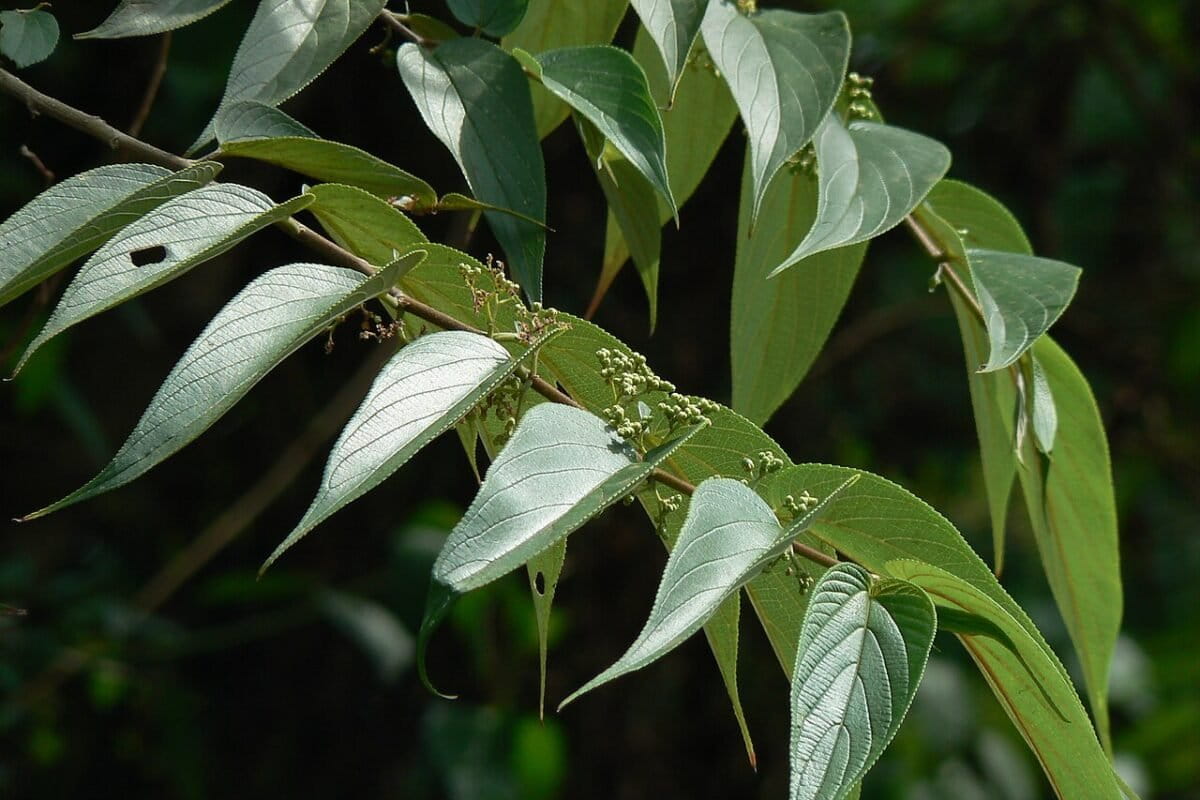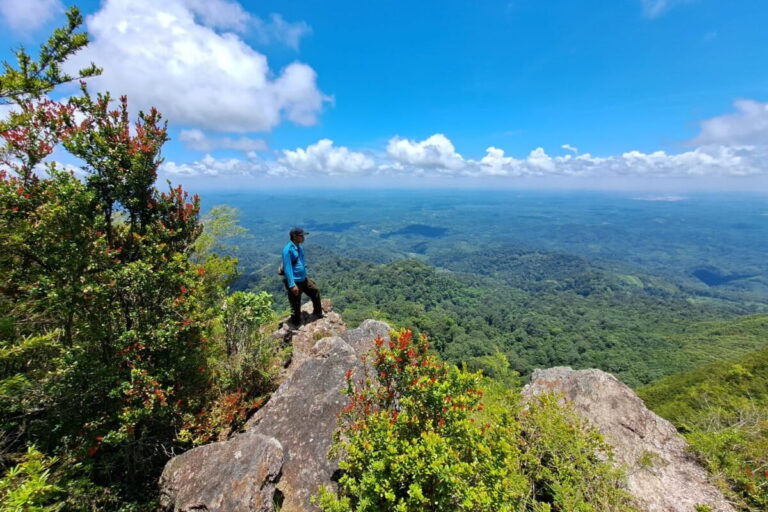- International researchers have described a new species of forest toad from Mount Kenya.
- Working with a single specimen collected eight years ago, the team dates the Kenyan volcano toad’s origins back 20 million years, long before Mount Kenya was formed.
- Researchers say the discovery highlights the rich biodiversity of the now-extinct volcano, and provides a fresh impetus to protect its unique habitats.
Eight years ago, a research team from the National Museums of Kenya stumbled upon an unfamiliar frog on the eastern flanks of Mount Kenya. The small green toad has now been identified: it’s not only a species new to science — it belongs to a group of toads whose origins extend back long before the mountain was formed 3 million years ago.
The researchers had been looking for other species in the mist-shrouded Chogoria Forest Block at an elevation of around 2,400 meters (7,900 feet) when they found the toad, now named the Kenyan volcano toad (Kenyaphrynoides vulcani).
They caught just one specimen, a male, in a pitfall trap on the forest floor in September 2015. The discovery has only just been reported in the Zoological Journal of the Linnean Society.

Herpetologist Victor Wasonga took a photograph of the toad the morning he collected it from the trap. It had long toe tips, a rough-skinned body blotched with green and brown, and dark and light bands on its legs. He sent the photograph to a colleague in Nairobi, Patrick Malonza.
“When they sent the photograph I told them, ‘This doesn’t look like an ordinary toad, it looks more like the forest toads that occur in the Eastern Arc Mountains of Tanzania,’” Malonza recalls.
The Eastern Arc Mountains comprise a string of isolated, forest-clad massifs that stretch across eastern Tanzania. They’re thought to be much older than Mount Kenya.
The captured toad was euthanized and preserved, and the following year the National Museums of Kenya sent the specimen to London. It was examined by Simon Loader, senior curator of vertebrates at London’s Natural History Museum, and evolutionary biologist Christoph Liedtke from the Doñana Biological Station in Spain. Both researchers have studied Tanzanian forest toads.
They confirmed the find was like no other species known from Kenya.

“Both the skeleton and the outside features showed that it was different, and was of its own species and its own genus,” Malonza says.
Malonza, who had previously carried out surveys of amphibians on Mount Kenya, visited the Chogoria Forest himself in 2017. He set pitfall traps and spent days and nights searching at the same site, but failed to find any more specimens of the new species, suggesting it is rare, or at least highly elusive.
The research team thinks the long toes suggest the volcano toad is a tree climber, and that like most other amphibians it’s active in the wet season. Its discovery on the ground in the dry season has, therefore, fueled their curiosity.
It could suggest that the species hides underground or in deep leaf litter until the rains fall. Given its similarity to forest toads from the Nectophrynoides genus in Tanzania, it’s also possible that female volcano toads give birth to live froglets, as opposed to laying eggs that go through a tadpole phase, the researchers say.
Mount Kenya is home to much bigger wildlife, including elephants (Loxodonta africana), black rhinos (Diceros bicornis) and mountain bongos (Tragelaphus eurycerus isaaci), a critically endangered antelope. But small, often overlooked animals like the new volcano toad provide fresh insight into the region’s ancient geological and biological past.
The researchers calculate the volcano toad’s genus diverged from similar lineages in the region around 20 million years ago. That would predate the existence of Mount Kenya, which geologists estimate is 3 million years old. The toad’s ancestors could have lived in forests that were once much more widespread, and interconnected, across the East African region.

“We’re not surprised that there are these deep lineages or distantly related frogs scattered and dispersed across the region,” Liedtke says, “but we were surprised that [the Kenyan volcano toad] is there, because it would suggest that there must have been some pockets of forest that offered refuge to these lineages; some pockets of forest that were perhaps older than the uprising of Mt. Kenya.”
Liedtke, who is the corresponding author of the new study, describes the discovery as “a bit of a reality check.” It shows researchers are still far from fully understanding the planet’s biodiversity, he says.
“We’re still finding organisms that represent these isolated and long branches of the tree of life.”
There are around 150 new species of amphibians described globally each year, but the description of a whole new genus is rare, says Lucinda Lawson, a conservation biologist at the University of Cincinnati, who wasn’t involved in the volcano toad’s discovery.
Lawson has searched Tanzania’s Eastern Arc Mountains for toads similar to the volcano toad, including the elusive Churamiti maridadi forest toad. Earlier this year, she and colleagues described a new species of silent reed frog from the arc’s Ukaguru massif.

Like the Eastern Arc’s forests, those on Mount Kenya face threats from agriculture, logging and development. Mount Kenya does, however, enjoy a high conservation profile. It’s recognized as a national park, a UNESCO World Heritage Site, a national water tower, a Key Biodiversity Area, among others.
“Kenya is very proactive in trying to protect their biodiversity as much as possible, though efforts can be hampered by limited resources,” Lawson says.
“What we need now are further surveys to understand its population size, distribution, and habitat requirements to better understand this species and what it will need to survive and flourish into the future.”
A 2019 report on the ecosystem services supplied by Mount Kenya found Mount Kenya the mountain’s forest structure was changing from closed-canopy forest to open-canopy forest at a rate of 1% per year.s. Unregulated livestock grazing, forest fires, illegal tree cutting, and the spread of exotic plantations were responsible.
Paul Gacheru, the report’s co-author and species and sites manager at the nonprofit Nature Kenya, says there are now heightened efforts to restore degraded areas. These include support for 28 community forest associations, the planting of around 100,000 indigenous trees per year, and other measures. “If the current efforts are sustained, including engagement of forest-adjacent communities, we envision improved habitat suitability for a broad range of species.”
With its colorful name, and ancient origins, the Kenyan volcano toad has the potential to become a mascot for such work.
“It’s a unique species restricted to Mount Kenya’s forests; it could be an additional flagship species to foster the conservation of the remaining forests,” Malonza says.
Those same forests could have further surprises in store, he adds.
“Given that this species has been found, and sampling has always been done there, it is likely that there are other new species that are yet to be discovered.”
Banner image of Mount Kenya by Rhett A. Butler.
Citation:
Liedtke, H. C., Malonza, P. K., Wasonga, D. V., Müller, H., & Loader, S. P. (2023). A new genus and species of toad from Mount Kenya illuminates East African montane biogeography. Zoological Journal of the Linnean Society. doi:10.1093/zoolinnean/zlad160
FEEDBACK: Use this form to send a message to the author of this post. If you want to post a public comment, you can do that at the bottom of the page.














